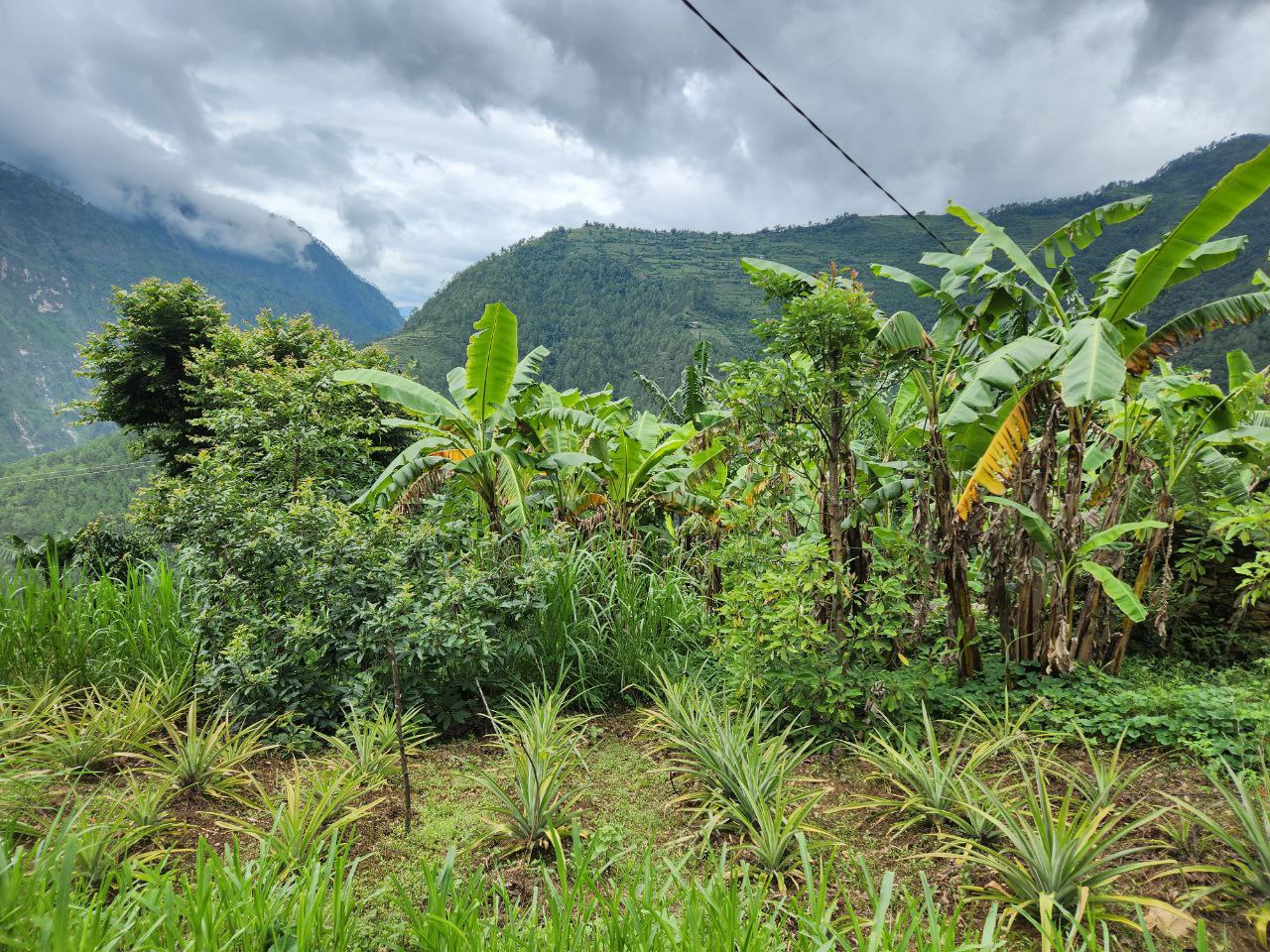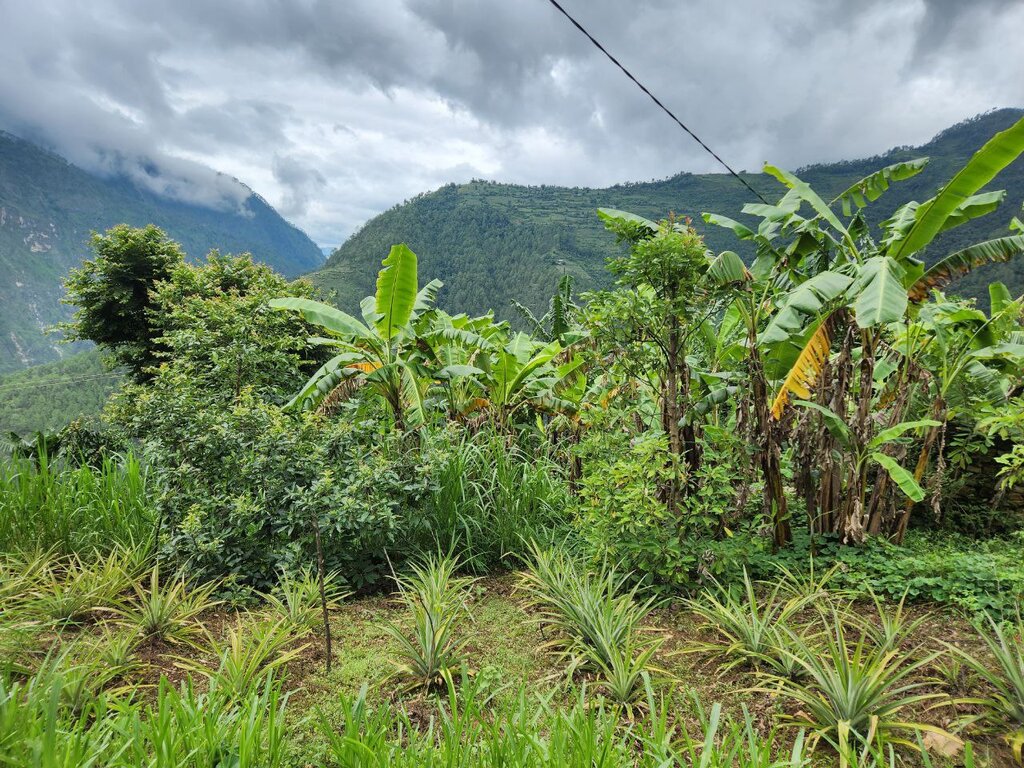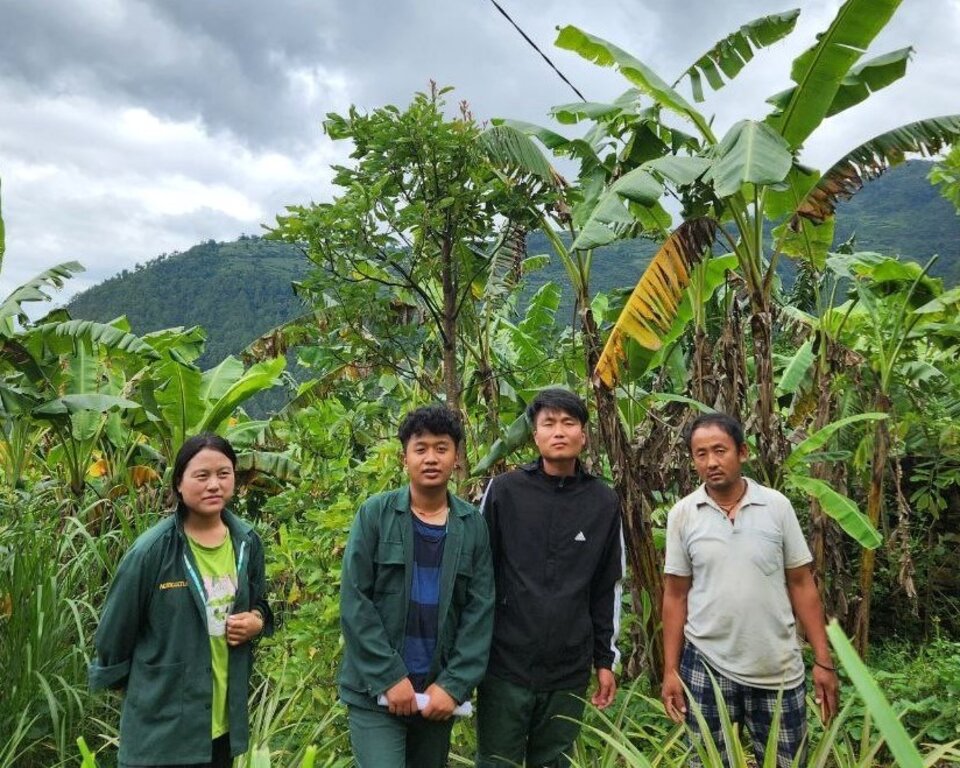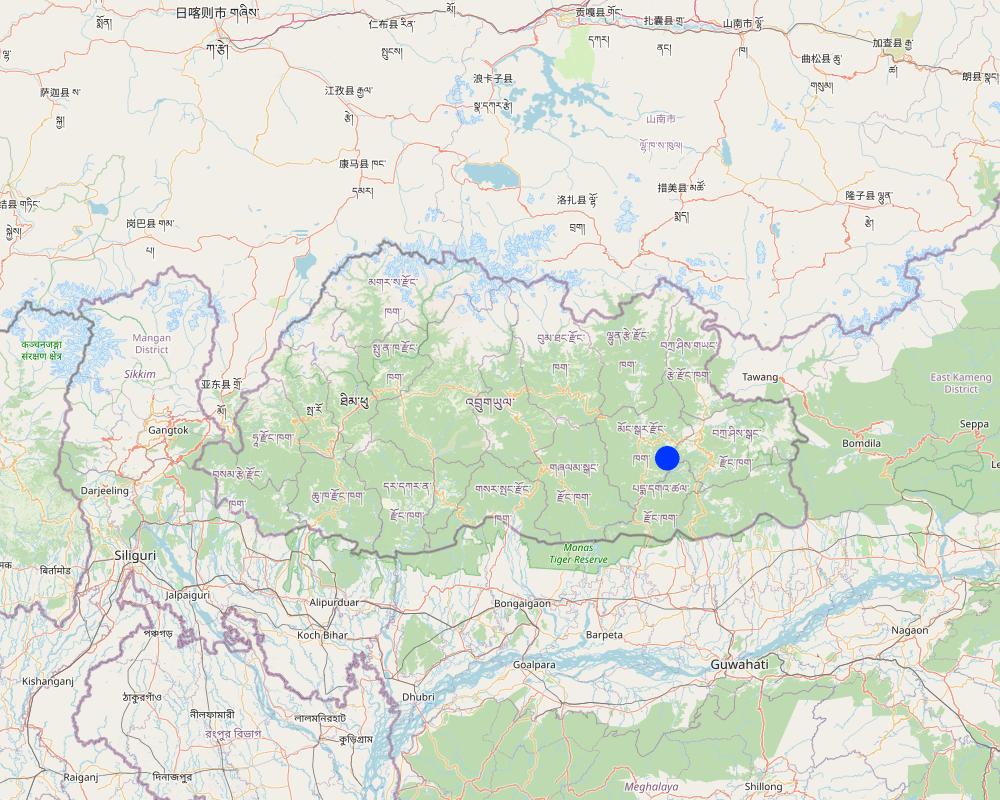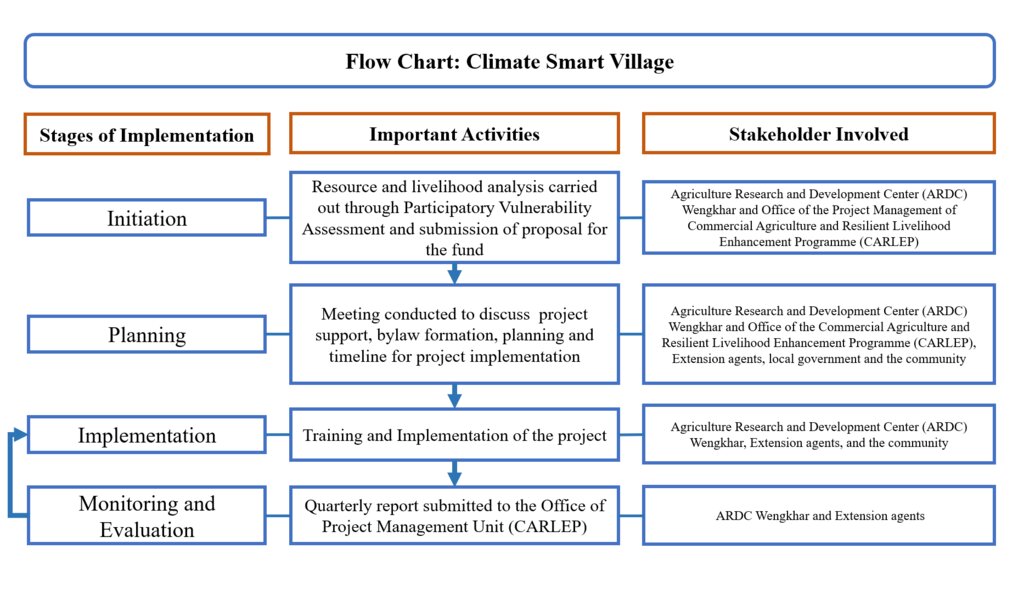Climate-Smart Village Approach [بوتان]
- تاريخ الإنشاء:
- تحديث:
- جامع المعلومات: ONGPO LEPCHA
- المحرر: –
- المراجعون: William Critchley, Rima Mekdaschi Studer
གནམ་གཤིས་ཐབས་ལམ་གྱི་གཡུས།
approaches_6852 - بوتان
عرض الأقسام
توسيع الكل طي الكل1. معلومات عامة
1.2 تفاصيل الاتصال بالأشخاص الرئيسيين لمصدر المعلومات والمؤسسات المعنية بتقييم وتوثيق النهج
الشخص (الأشخاص) الرئيسي لمصدر المعلومات
مستخدم الأرض:
Yangki Karma
77211775
Ngaru-Pongtang village
Ngaru-Pongtang village, Thangrong gewog (block), Mongar Dzongkhag (district), Bhutan
بوتان
مستخدم الأرض:
Lhaden Sanga
77625788
Ngaru-Pongtang village
Ngaru-Pongtang village, Thangrong gewog, Mongar Dzongkhag, Bhutan
بوتان
مستخدم الأرض:
Lhendup
17526138
Ngaru-Pongtang village
Ngaru-Pongtang village, Thangrong gewog, Mongar Dzongkhag, Bhutan
بوتان
اسم المشروع الذي سهّل توثيق/تقييم النهج (إذا كان ذلك على صلة)
Strengthening national-level institutional and professional capacities of country Parties towards enhanced UNCCD monitoring and reporting – GEF 7 EA Umbrella II (GEF 7 UNCCD Enabling Activities_Umbrella II)اسم المؤسسة (المؤسسات) التي سهلت توثيق/تقييم النهج (إذا كان ذلك على صلة)
National Soil Services Centre, Department of Agriculture, Ministry of Agriculture & Livestock (NSSC) - بوتان1.3 الشروط المتعلقة باستخدام البيانات الموثقة من خلال WOCAT
متى تم تجميع البيانات (ميدانيا)؟:
15/07/2023
يوافق جامع المعلومات والشخص (لاشخاص) الرئيسي لمصدر المعلومات على الشروط المتعلقة باستخدام البيانات الموثقة من خلال WOCAT:
نعم
2. وصف نهج الإدارة المستدامة للأراضي
2.1 وصف موجز للنهج
Climate change has become inevitable, and there is a need to address this impending danger. In the Climate-Smart Village (CSV) approach, land users in Ngaru-Pongtang have implemented several technologies and innovations to address climate change impacts, and the programme has worked with 50 households on a total area of 137 acres (55 ha).
2.2 وصف تفصيلي للنهج
وصف تفصيلي للنهج:
This approach focused on transforming Ngaru-Pontang into a Climate-Smart Village (CSV) with actions that also contribute to mitigating climate change. The programme has worked with 50 households on a total area of 137 acres (55 ha). The approach included a participatory vulnerability assessment, and extensive training and education for the land users. They were equipped with skills, technologies, and innovative practices related to climate-smart agriculture (CSA). Additionally, the approach emphasized collaborative efforts, working closely with community members to foster better engagement and cooperation.
The primary objectives of the approach were to transform Ngaru-Pontang village into a CSV and thus effectively address the challenges posed by climate change. To achieve these goals, the approach employed various methods. It involved meetings with the community members, vulnerability assessment, fostering collaboration between the community, Agriculture Research and Development Centre (ARDC) Wengkhar, and Commercial Agriculture and the Resilient Livelihood Enhancement Programme (CARLEP). The community members received comprehensive training and attended workshops on climate-smart agriculture practices.
The implementation of the approach adopted the following stages:
1. Resource and livelihood analysis carried out through a Participatory Vulnerability Assessment.
2. Based on the findings from the above assessment, a project proposal was submitted to secure funding.
3. Subsequently, discussions were held with the community members, the extension agent, and the local government to ensure collective agreement and support.
4. A detailed plan with a timeline was developed to guide project implementation and monitoring.
5. Training and workshops on CSA practices were conducted by the ARDC and the extension agent, empowering the community members to take charge of project implementation and ensure sustainability.
Key stakeholders involved in the approach included:
1. ARDC Wenkhar, which led the implementation of the project, facilitated the training and workshops, provided technical assistance, and monitored the programme's progress.
2. The Gewog administration and the extension agent played crucial roles by offering support and assistance in implementing climate-smart agriculture practices in the field.
3. The community members actively participated in various program activities, playing a pivotal role in driving the project forward.
4. The Commercial Agriculture and Resilient Livelihood Enhancement Programme (CARLEP) acted as the funding agency.
The key CSA practices implemented through this approach are soil fertility improvement technologies (composting through use of FYM and bio-slurry, vermicomposting; liquid manure, biochar, Bhutan Agri-Microbial Solution (BAMS) and hedgerow plantations), community solar-electric fencing, heat and drought tolerant crops (spring paddy, soybean, avocados, mangoes and pineapples), biogas installations and establishment of weather station.
The implementation of CSA interventions has resulted in a wide range of impacts on livelihoods, income, and enhanced climate resilience. The diversification of crops, electric fencing, and improvement in irrigation have enabled farmers to expand their cultivation area thereby directly enhancing crop production and cash income. Similarly, the integration of improved livestock farming systems along with crops and the installation of biogas plants have reduced impacts on natural resources. Farmers have gained knowledge and exposure to different climate-smart agriculture practices. The only negative impact of the measures has been extra damage to crops by wild animals.
2.3 صور عن النهج
2.5 البلد/المنطقة/المواقع التي تم تطبيق النهج فيها
البلد:
بوتان
المنطقة/الولاية/المحافظة:
Mongar Dzongkhag
مزيد من التفاصيل حول الموقع:
Ngaru-Pongtang village, Thangrong gewog
Map
×2.6 تواريخ بدء وإنهاء تنفيذ النهج
أشر إلى سنة البدء:
2016
سنة الإنهاء (إذا لم يعد النهج مطبقًا):
2021
التعليقات:
The establishment of the CSV was between 2016 to 2021, but activities continue to progress despite the completion of the project.
2.7 نوع النهج
- قائم على مشروع/برنامج
2.8 الغايات/الأهداف الرئيسية للنهج
The main objective of the approach was to establish Ngaru-Pongtang as a CSV and showcase different CSA practices geared towards combating, mitigating and addressing climate change impacts, which can be replicated to other gewogs and Dzongkhags.
2.9 الظروف التي تمكن أو تعيق تنفيذ التقنية/التقنيات المطبقة بموجب النهج
توفر/الوصول إلى الموارد والخدمات المالية
- تمكين/تمكيني
Community members were provided with equipment and planting materials through project's support.
الإطار المؤسساتي
- تمكين/تمكيني
Local government and gewog agriculture extension agent were involved during the training, seminars and the implementation of the project activities to ensure ownership and sustainability of the project.
التعاون/التنسيق بين الجهات الفاعلة
- تمكين/تمكيني
Stakeholders (ARDC Wengkhar, local government and community members) participated and cooperated together during the entire project period.
المعرفة حول الإدارة المستدامة للأراضي، والوصول إلى الدعم الفني
- تمكين/تمكيني
ARDC Wengkhar provided regular training and workshops with regard to climate-smart agriculture, good agricultural practices and sustainable land management for the successful implementation of the project.
الأسواق (لشراء المدخلات وبيع المنتجات) والأسعار
- تمكين/تمكيني
ARDC Wengkhar has facilitated agricultural marketing by linking up the community with Bhutan Agro-Industry located at Lingmethang, Mongar.
3. المشاركة وأدوار الأطراف المعنية
3.1 أصحاب المصلحة المعنيون بالنهج وأدوارهم
- مستخدمو الأراضي المحليون/المجتمعات المحلية
Ngaru-Pongtang community
As a beneficiary, participated actively in the planning and implementation of the project activities, ensuring the project was successful and beneficial to them.
- الباحثون
ARDC Wenkhar
Led the implementation of the project; facilitated the training and the workshops; provided technical assistance to the program; and monitored the progress of the program.
- الحكومة المحلية
Gewog administration and gewog agriculture office
They provided administrative support and collaborated with other stakeholders in successful designing and implementation of the project activities.
- منظمة دولية
International Fund for Agricultural Development (IFAD)
IFAD provided financial assistance through its Commercial Agriculture and Resilient Livelihood Enhancement Programme (CARLEP)
3.2 انخراط مستخدمي الأراضي المحليين/المجتمعات المحلية في المراحل المختلفة للنهج
| انخراط مستخدمي الأراضي المحليين/المجتمعات المحلية | حدد من شارك وصف الأنشطة | |
|---|---|---|
| المبادرة/التحفيز | سلبي | The local community members were informed verbally and through community meeting about the project. |
| التخطيط | تفاعلي | ARDC Wengkhar, Thangrong gewog administration, gewog agriculture extension agent and the community members came together and discussed the way forward for the project. |
| التنفيذ | تفاعلي | Community members were provided with training and workshops on climate-smart agriculture and related agricultural skills. After the training and demonstrations, land users were divided into groups and made to apply these skills in their field. |
| الرصد/التقييم | تفاعلي | Monitoring is being sporadically conducted by ARDC Wengkhar and the gewog agriculture extension agent, but it is left to the land users to monitor their own fields. |
3.3 مخطط التدفق (إذا كان متاحًا)
الوصف:
The flowchart was created based on the information provided by the community members
المؤلف:
Ongpo Lepcha
3.4 اتخاذ القرار بشأن اختيار تقنية/تقنيات الإدارة المستدامة للأراضي
حدد من الذي قرر اختيار التقنية/التقنيات التي سيتم تنفيذها:
- متخصصون في الإدارة المستدامة للأراضي بشكل أساسي، بعد التشاور مع مستخدمي الأراضي
اشرح:
ARDC Wenkhar was responsible for deciding on what technologies and innovations to apply in the community, however, this was done based on consultation and discussions with the community members of Ngaru-Pongtang.
حدد على أي أساس تم اتخاذ القرارات:
- تقييم المعرفة الموثقة جيدًا بشأن الإدارة المستدامة للأراضي(اتخاذ القرارات القائمة على الأدلة)
- Consultation with the community members
4. الدعم الفني وبناء القدرات وإدارة المعرفة
4.1 بناء القدرات/التدريب
هل تم تقديم التدريب لمستخدمي الأراضي / الأطراف المعنيين الآخرين؟:
نعم
حدد من تم تدريبه:
- مستخدمو الأراضي
إذا كان ذلك على صلة، حدد الجنس والعمر والوضع والعرق وما إلى ذلك.
Both males and females were trained.
شكل التدريب:
- من مزارع إلى مزارع
- مناطق العرض
- اجتماعات عامة
المواضيع المغطاة:
The topics covered included climate-smart agriculture, sustainable land management, and good agricultural practices.
التعليقات:
The capacity building was conducted by the Agriculture Research Development Center (ARDC) in Wengkhar and the participants included community members. The program was coordinated, facilitated, and implemented by an extension agent in collaboration with Local Government and beneficiaries.
4.2 خدمة استشارية
هل يملك مستخدمو الأراضي وصولا إلى خدمة استشارية؟:
نعم
حدد ما إذا كانت الخدمة الاستشارية متوفرة:
- في حقول مستخدمي الأراضي
وصف/تعليقات:
ARDC Wengkhar and the agricultural extension agent provided all the technical advice and assistance required by the community members.
4.3 تعزيز المؤسسات (التطوير التنظيمي)
هل تم إنشاء أو تعزيز مؤسسات من خلال هذا النهج؟:
- نعم، باعتدال
حدد المستوى (المستويات) التي تم فيها تعزيز أو إنشاء المؤسسات:
- محلي
صف المؤسسة والأدوار والمسؤوليات والأعضاء وما إلى ذلك.
The local government was involved in the project from start till end, which enhanced their understanding and capacity to initiate and replicate similar projects in other villages.
حدد نوع الدعم:
- بناء القدرات/التدريب
- Technical assistance
اعط مزيدا من التفاصيل:
Local government officials were engaged in the capacity building programs implemented for the community and also provided technical assistance as and when required.
4.4 الرصد والتقييم
هل يشكل الرصد والتقييم جزءا من النهج؟:
نعم
التعليقات:
ARDC Wenkhar and the agriculture extension agent sporadically conducted monitoring and evaluation. However, the local land users are given the full responsibility to monitor their own fields and seek assistance when required.
إذا كانت الإجابة بنعم، فهل من المقصود استخدام هذه الوثائق للمراقبة والتقييم؟:
كلا
4.5 البحوث
هل كانت البحوث جزءًا من النهج؟:
نعم
- Vulnerability Assessment
أعط تفاصيل إضافية وأشر إلى من قام بالبحوث:
ARDC Wengkhar conducted a resource and livelihoods analysis through vulnerability assessment before designing and implementng the project in the community.
5. التمويل والدعم المادي الخارجي
5.1 الميزانية السنوية لمكون الإدارة المستدامة للأراضي في النهج المذكور
أشر إلى ميزانية النهج السنوية لمكون الإدارة المستدامة للأراضي بالدولار الأمريكي:
55920,82
التعليقات (على سبيل المثال المصادر الرئيسية للتمويل/الجهات المانحة الرئيسية):
The funding was through Commercial Agriculture and Resilient Livelihoods Enhancement Programme (CARLEP) funded by International Fund for Agricultural Development (IFAD).
5.2 الدعم المالي/المادي المقدم لمستخدمي الأراضي
هل حصل مستخدمو الأراضي على دعم مالي/ مادي لتنفيذ التقنية/ التقنيات؟:
نعم
إذا كانت الإجابة بنعم، حدد نوع (أنواع) الدعم والشروط والمزودين:
Material inputs such as seeds and seedlings, organic fertilizers, sprinkler pipes, and green shade net were provided through the project.
5.3 إعانات لمدخلات محددة (بما في ذلك العمالة)
- معدات
| حدد المدخلات التي تم دعمها | إلى أي مدى | حدد الإعانات |
|---|---|---|
| الآلات | ممول جزئيا | Sprinkler pipes and green shade nets |
- زراعة
| حدد المدخلات التي تم دعمها | إلى أي مدى | حدد الإعانات |
|---|---|---|
| بذور | ممول بالكامل | Seeds and saplings |
| أسمدة | ممول بالكامل | Organic fertilizers |
إذا كان العمل من قبل مستخدمي الأراضي مدخلاً جوهريًا، فهل كان:
- تطوعي
التعليقات:
The project beneficiaries arranged their own family labour or through informal labour exchange model.
5.4 الائتمان
هل تم توفير ائتمان في إطار نهج أنشطة الإدارة المستدامة للأراضي؟:
كلا
5.5 حوافز أو وسائل أخرى
هل تم استخدام حوافز أو أدوات أخرى لتشجيع تنفيذ تقنيات الإدارة المستدامة للأراضي؟:
كلا
6. تحليل الأثر والتصريحات الختامية
6.1 آثار النهج
هل ساهم النهج في تمكين مستخدمي الأراضي المحليين وتحسين مشاركة الأطراف المعنية؟:
- لا
- نعم، قليلا
- نعم، باعتدال
- نعم، إلى حد كبير
The project built capacity of the land users and are able to implement and monitor project activities in their own fields.
هل ساعد النهج مستخدمي الأراضي على تنفيذ وصيانة تقنيات الإدارة المستدامة للأراضي؟:
- لا
- نعم، قليلا
- نعم، باعتدال
- نعم، إلى حد كبير
Conducting training and workshops were part of the approach and therefore this made implementing and maintaining the sustainability of the project possible.
هل أدى النهج إلى تحسين معرفة وقدرات مستخدمي الأراضي على تنفيذ الإدارة المستدامة للأراضي؟:
- لا
- نعم، قليلا
- نعم، باعتدال
- نعم، إلى حد كبير
The training and workshop helped provide knowledge and skills regarding sustainable land management and climate smart agriculture practices.
هل أدى النهج إلى تحسين معرفة وقدرات الأطراف المعنية الأخرى؟:
- لا
- نعم، قليلا
- نعم، باعتدال
- نعم، إلى حد كبير
The project enabled local government to enhance their knowledge and capacity through direct engagement in the training program and in the implementation of the project activities in the field.
هل ساهم النهج في تمكين الفئات المحرومة اجتماعيا واقتصاديا؟:
- لا
- نعم، قليلا
- نعم، باعتدال
- نعم، إلى حد كبير
The project benefited all the community members equally disregarding of their background.
هل أدى هذا النهج إلى تحسين الأمن الغذائي / تحسين التغذية؟:
- لا
- نعم، قليلا
- نعم، باعتدال
- نعم، إلى حد كبير
The climate-smart agriculture practices have improved the agricultural production through crop diversification, electric fencing and irrigation water improvement.
هل أدى النهج إلى تحسين الوصول إلى الأسواق؟:
- لا
- نعم، قليلا
- نعم، باعتدال
- نعم، إلى حد كبير
ARDC Wengkhar and the local government have facilitated the market by linking the community with Bhutan Agro-industry for processing.
هل أدى النهج إلى تحسين قدرة مستخدمي الأراضي على التكيف مع التغيرات المناخية/الظواهر المناخية المتطرفة والتخفيف من الكوارث المرتبطة بالمناخ؟:
- لا
- نعم، قليلا
- نعم، باعتدال
- نعم، إلى حد كبير
Land users were trained on climate-smart agriculture and most importantly the land users have implemented climate smart agriculture practices in their fields which will definitely help build their capacity to adapt to the climate change.
6.2 المحفز الرئيسي لقيام مستخدمي الأراضي بتنفيذ الإدارة المستدامة للأراضي
- زيادة الإنتاج
The diversification of crops (drought resistant crop varieties), improvement of irrigation water and electric fencing have helped to expand cultivation and enhance production.
- زيادة الربح (القدرة)، وتحسين نسبة التكلفة إلى العائد
Facilitation of market linkage wth Bhutan Agro-Industry has provided assured market for the local produce.
- تعزيز المعرفة والمهارات في مجال الإدارة المستدامة للأراضي
The community members have been trained on SLM and CSA practices.
- Adapt and mitigate climate change
CSA practices including SLM has minimised soil erosion, increased soil organic matter, conserved soil moisture and improved the overall soil health.
6.3 استدامة أنشطة النهج
هل يمكن لمستخدمي الأراضي المحافظة على استدامة ما تم تنفيذه من خلال النهج (بدون دعم خارجي)؟:
- نعم
إذا كانت الإجابة بنعم، صف كيف:
The land users have built their capacity, improved their production and cash income which should enable them to sustain the project activities.
6.4 نقاط قوة/مزايا النهج
| نقاط القوة/ المزايا/ الفرص من وجهة نظر مستخدمي الأراضي |
|---|
| Capacity building and technical assistance on CSA and SLM were provided. |
| Gained knowledge and skills on CSA practices |
| Were able to increase crop production through CSA interventions |
| Were provided with an assured market for their produce |
| نقاط القوة/ المزايا/ الفرص من وجهة نظر جامع المعلومات أو غيره من الاشخاص الرئيسيين لمصدر المعلومات |
|---|
| Built human and natural capital through capacity building and implementation of CSA practices. |
| Enhanced community resilience to climate change impacts |
6.5 نقاط الضعف/ العيوب في المنهج وطرق التغلب عليها
| نقاط الضعف/ المساوىء/ المخاطر من وجهة نظر مستخدم الأراضي | كيف يمكن التغلب عليها؟ |
|---|---|
| The approach didn't address the pest problem, specifically the vertebrate pest adequately. | Explore additional funding to support electric fencing and if possible chain link fencing. |
| Farmers' hesitance to adopt technology. | Create adequate awareness prior to actual design an implementation of the project. |
7. المراجع والروابط
7.1 طرق جمع/مصادر المعلومات
- مقابلات مع مستخدمي الأراضي
3 individuals
7.2 المراجع للمنشورات المتاحة
العنوان، المؤلف، السنة، النظام القياسي الدولي لترقيم الكتب ISBN:
Saanogo, D, Sail, M., & Camara, B. A.. (2020). The climate-smart village approach: putting communities at the heart of restoration. Tropenbos International, Wageningen.
متاح من أين؟كم التكلفة؟:
https://www.tropenbos.org/file.php/2385/etfrn-news-60-sanogo-the-climate-smart-village-approach.pdf
العنوان، المؤلف، السنة، النظام القياسي الدولي لترقيم الكتب ISBN:
Aggarwal, P. K., Jarvis, A., Campbell, B. M., & Zougmore, R. (2018). The climate-smart village approach: Framework of an integrative strategy for scaling up adaptation options in agriculture. Ecology and Society, 23(1).
متاح من أين؟كم التكلفة؟:
https://www.researchgate.net/publication/322765373_The_climate-smart_village_approach_Framework_of_an_integrative_strategy_for_scaling_up_adaptation_options_in_agriculture
7.3 روابط للمعلومات ذات الصلة المتوفرة على الإنترنت
العنوان/الوصف:
The climate smart villages approach
عنوان الرابط URL:
https://www.grida.no/resources/4928
العنوان/الوصف:
THE CLIMATE-SMART VILLAGE APPROACH: FRAMEWORK OF AN INTEGRATIVE STRATEGY FOR SCALING UP ADAPTATION OPTIONS IN AGRICULTURE
عنوان الرابط URL:
https://ccafs.cgiar.org/resources/publications/climate-smart-village-approach-framework-integrative-strategy-scaling
الروابط والوحدات المواضيعية
توسيع الكل طي الكلالروابط
لا يوجد روابط
الوحدات المواضيعية
لا يوجد وحدات مواضيعية


